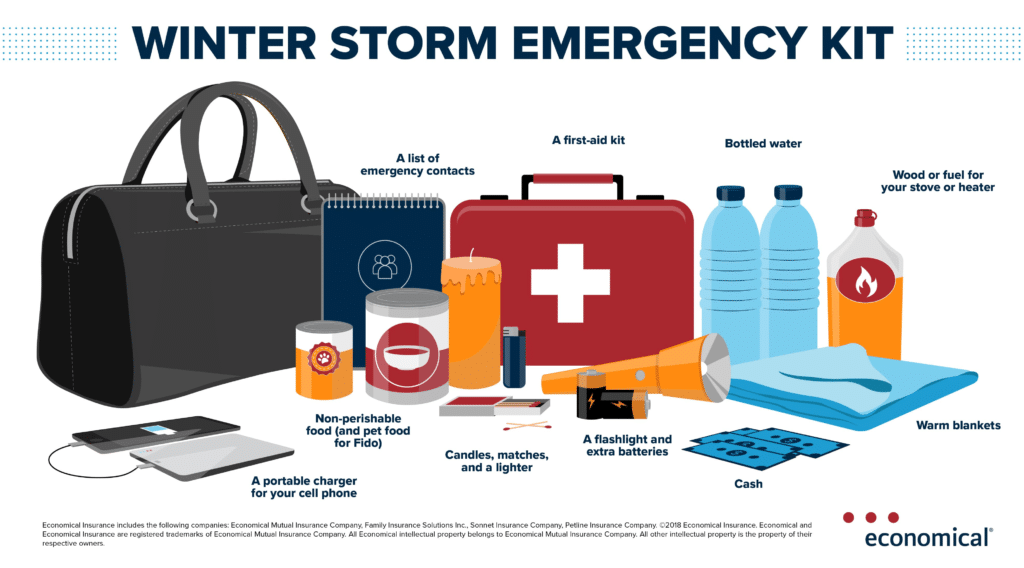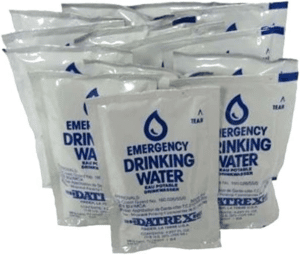A Guide of What to do During a Blizzard
Preparing for blizzard begins way before one is announced on the news.
If you ever been part of a blizzard, you are familiar with the sight: high winds, fast accumulating snow fall, low visibility, freezing temperatures, and icy conditions. Now more than ever, blizzards are affecting areas that were not accustomed to that type of weather. As a result, power outages, traffic accidents, and other problems have become prevalent, especially in areas not equipped to handle these weather events.

But what about you? Are you prepared for a blizzard? Sure, we might have a shovel or some salt, but do you have provisions, a plan, supplies, and more in case you and your family are unable to leave for sometime? What if damage happens to your home? Do you have a go bag? Of course, we all hope for the best, but as we like to say, it is even better to prepare for the worst. And so, let’s discuss what to do during a blizzard.
Please note that this post contains affiliate links. If you use these links to buy something we may earn a commission. Thanks.
What is a Blizzard?
Okay. I know what you might be thinking. Are you really about to define what a blizzard is?!?!? Yes, we are and you will see why in a moment.
A blizzard is a severe winter storm that is characterized by heavy snowfall, strong winds, and extremely low visibility. A blizzard typically occurs when a low-pressure system brings moist air from the Gulf of Mexico or Atlantic Ocean and meets a mass of cold, arctic air. The combination of heavy snow, strong winds, and low visibility creates dangerous conditions for people and can cause widespread power outages, transportation disruptions, and other hazards.

Now here is the kicker: For a storm to be classified as a blizzard, the following conditions must be met:
- Snowfall: There must be falling or blowing snow that reduces visibility to less than a quarter of a mile for at least three hours.
- Wind: Wind speeds must be at least 35 mph.
- Temperatures: Temperatures must be below freezing.
So a blizzard is more than just your average snowfall or snow storm. We are talking heavy snow, low visibility, heavy winds, and low temperatures. Blizzards can cause significant damage and are a serious threat to life and property. So, it is important to be prepared and follow the recommendations of local authorities during a blizzard.
What are Blizzard Warnings?
Like any other serious weather storm, blizzards come with warnings that when observe will alert you to potential dangers. These warnings are issued by weather agencies such as the National Weather Service (NWS) and contain valuable information. Knowing what they mean can help you better understand how to prepare and what to do next.
There are several types of blizzard warnings that may be issued, including:
- Winter Storm Warning: Issued for a winter storm that is expected to produce heavy snow and/or ice, causing hazardous or life-threatening conditions.
- Blizzard Warning: Issued for a winter storm that is expected to produce heavy snow and/or ice, causing dangerous wind speeds and low visibility.
- Wind Chill Warning: Issued when extremely cold wind chills are expected to cause hypothermia or frostbite.
- Heavy Snow Warning: Issued when heavy snow is expected to fall, causing hazardous driving conditions and possible power outages.
- Lake-Effect Snow Warning: Issued for areas near the Great Lakes when heavy snowfall is expected as a result of lake-effect snow.
It’s important to stay informed and follow the recommendations of weather agencies during a blizzard warning. This may include staying indoors, avoiding travel, and being prepared for power outages and other emergencies.
Seven Things to Do Before a Blizzard
Keeping in mind that a blizzard is more than just a simple snowfall, preparing is important to ensure your safety and the safety of those around you. So let’s briefly highlight seven things you can do before a blizzard:
- Monitor weather forecasts: Keep an eye on weather forecasts and updates from reliable sources such as the National Weather Service. Special emphasis on the word, reliable. There are a lot of reports that are meant to entertain. Avoid those! Rather focus on official weather reports that will help you stay informed and plan accordingly.
- Stock up on supplies: Make sure you have enough food, water, first aid, and medication for at least three days. Have enough batteries, flashlights, and blankets, in case of power outages. Do not wait until the last minute to go shopping and do not panic buy. It is always helpful to have the aforementioned supplies on hand ahead of time.
- Prepare your home: Insulate your home and ensure that windows and doors are properly sealed. Make sure your heating system is in good working condition. If you have a generator, make sure it’s in good working condition as well.
- Plan your travel: If you must travel, make sure your vehicle is equipped with snow tires or chains. Also, make sure you have enough fuel, and a shovel and ice scraper in your car.
- Stay informed: Keep your phone charged and stay tuned to local news and weather reports. Make sure you have emergency contacts saved in your phone and let someone know your whereabouts. Two suggestions: 1) Have an emergency radio, and 2) Have a print out of emergency contacts.
- Bring pets indoors: Bring all pets inside and make sure they have enough food and water. If you have livestock or outdoor pets, make sure they have adequate shelter and food.
- Avoid unnecessary travel: If possible, avoid travel during a blizzard, as it can be dangerous and increase the risk of accidents.
Again, preparation is key to staying safe during a blizzard. No one wants to find themselves lacking the necessities or information in such a weather event.

What to Do During a Blizzard
When younger, a blizzard meant no school and watching re-runs all day. The good old times! During a blizzard, it is important to stay safe and warm. Some recommended steps include:
- Stay indoors: Please stay indoors! Avoid going outside during a blizzard as the conditions can be dangerous and visibility is limited. Wait for blizzard conditions to stop before trying to shovel.
- Keep warm: Wear warm clothing, use blankets, and stay active to keep your body temperature up.
- Stay informed: Stay informed about the blizzard conditions and any emergency updates or warnings through the news, radio, or emergency alert systems.
- Avoid driving: If you must go outside, avoid driving as roads are likely to be treacherous and visibility is poor.
- Check on neighbors: If you are able, check on elderly or vulnerable neighbors to ensure they are safe and have adequate supplies.
Items to Put in Go Bag
 | Food | Buy on Amazon |
 | Food | Buy on Amazon |
 | Food | Buy on Amazon |
 | Water | Buy on Amazon |
 | Water Purification Straw | Buy on Amazon |
 | Water Purification Tablets | Buy on Amazon |
 | Tent | Buy on Amazon |
 | Bivy Sack | Buy on Amazon |
 | Blankets | Buy on Amazon |
 | Ponchos | Buy on Amazon |
 | First Aid Kit | Buy on Amazon |
 | Emergency Radio | Buy on Amazon |
 | Pocket Knife Multitool | Buy on Amazon |
 | Glow Light Sticks | Buy on Amazon |
 | Masks | Buy on Amazon |
 | Whistle | Buy on Amazon |
 | Flashlight | Buy on Amazon |
 | Survival Kit | Buy on Amazon |
 | Rope | Buy on Amazon |
 | Portable Lighting | Buy on Amazon |
 | Flash Drive | Buy on Amazon |
 | Backpack | Buy on Amazon |
 | Waterproof Folder | Buy on Amazon |
 | Battery Pack | Buy on Amazon |
Be Prepared

While a blizzard is a scary weather event, you and your family can be safe with proper preparation. Having experienced them multiple times in my life, we can attest to the importance of preparation. So stay informed, stay alert, and be sure to be prepared. If you do, you’ll be in a better position to stay safe during a blizzard.
Ready to make your emergency go bag?
Stay one step ahead of a disaster later by taking steps to prepare now.
–
If you enjoyed this page, please check out the rest of our disaster preparedness series:
- Earthquake Preparedness: How to Stay Safe
- Staying Safe: What to do During and After a Flood
- Hurricane Preparedness: Protecting Your Home and Family
- Surviving the Storm: Tips and Strategies for Tornado Readiness
- Living Near a Volcano: A Comprehensive Guide to Volcano Eruption Preparedness
- Don’t Get Caught Off Guard: Essential Steps for Wildfire Preparedness

